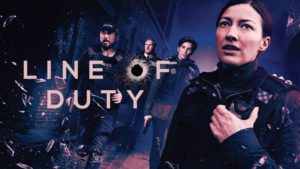Lockdown, Lowdown… Ringside Report Looks At the BBC TV Show Line of Duty
 By Donald “Braveheart” Stewart
By Donald “Braveheart” Stewart
There has been a televisual frenzy over the last few years about a BBC drama, Line of Duty. It has had a number of series which has sparked a Friends like devotion.
Based upon the work that anti-corruption police officers do, Line of Duty manages to give us the thrill and excitement of finding out who the baddies are within the goodies.
But there was a police procedural we all watched long before Line of Duty which was based on the same premise – goodies, chasing the baddies within the goodies.
Between the Lines ran on the BBC from 1992 to 1994 with 35 episodes which were broadcast over 3 series. It was a short run but one which stayed long in the memory.
Starring Neil Pearson, Tom Georgeson and Siobhan Redmond, as the three principal characters, DS Tony Clark (Pearson), Harry Naylor (Georgeson) and Mo Connell (Redmond) as they hunted down and tried to remove the corrupt from the good. They were the employed by the Complaints Investigation Bureau – the CIB, a fictional organization based upon anti-corruption officers in the police force at the time.
It therefore hit upon the zeitgeist of the times as the 1990’s had been filled with stories of police corruption and dodgy dealings by the people we would naturally assume were there to protect us. Pearson also created a flawed lead whose private life became as complex as his career pathway as he found himself trying to fulfil both sides of an ambitious personality. Constantly at odds with his boss, Deakin – played by Tony Doyle, who was a tough former Royal Ulster Constabulary (RUC) policeman this again fit the times. We were increasingly concerned with the role that the RUC was playing in stoking up the troubles in Northern Ireland where they were supposed to be the arbiters of justice in the province; eventually Deakin himself is exposed as being a little less than pure.
For the first two series the three principals were working within a police service context as they were serving police officers. By the end of the second they are ready to move on and by the beginning of the third they are working for private security. By the end of the third, Clark and Naylor look as though they have been killed, betrayed by their former boss Deakin and their colleague Connell. It shocked.
Perhaps equally shocking was picking up a BAFTA award in 1994, or the fact that Between the Lines gave us the first UK mainstream character who was bi-sexual, but whose sexuality is immaterial to the plot. Mo Connell led our way.
A number of “names” appeared in the three series, including future James Bond, Daniel Craig, David Morrissey who would at some point be Walking Dead, Downton Abbey’s Lord Grantham, Hugh Bonneville and the future Sherlock in Elementary, Johnny Lee Miller, as well as the acting titan that is Ray Winstone.
By the end of filming the final series, Pearson was ready to go. The last episodes were to be an unequivocal send off for his character. Scorching any possibility of remakes and a return to either the role or the series, Pearson was interviewed years later and was very clear that the final episode in series three was the final episode ever.
At its strongest, Between the Lines was best with its original premise. The third series was quite convoluted and though we got the highly attractive world of spies it did not hold the same appeal, as we were now moving beyond the Cold War into new eras, as the original idea of corrupt policemen. We liked the idea of holding those we were reading about in our daily newspapers to account in a fictional tale! Returning to it in Line of Duty has managed to confirm that and though it has now completed its 6th series and there are plans for plenty more, its genesis owes much to the trailblazing way in which Between the Lines led their way.
British television is a curious affair. Begun through the British Broadcasting Corporation (BBC) it is funded through the universal license fee. In essence, if you wanted to watch the television , you had to pay the license fee. The BBC got it all and is state run, albeit at arms-length. Then came along commercial television in the form of the Independent Television (ITV) in 1955. Designed to bring a bit of competition to the BBC, it was paid for through advertising but still free to air… well they didn’t add another license fee to it. By the time that I was born, 1965, there was BBC1, BBC2 and ITV. And that was it. It was still years before Bruce Springsteen would moan that there were 55 channels and nothing on but here in the UK, we kept this going until in 1982, we added a fourth channel and in 1997, a fifth. With sparkling imagination, they were called Channel Four and ehm Channel Five… In between came Sky and we understood what Springsteen meant. And so, my childhood and leading up to early adulthood we had three options… But the programs made were exceptionally good. And so, here is some critical nostalgia as the lockdown has brought a plethora of reruns, new formats and platforms and old classics trying to make their way back into our consciousness as broadcasters flood their schedules with classics… or are they classics at all? Let me take you through an armchair critics’ view of what we have to see, to find out… Welcome to the Lockdown Lowdown…
[si-contact-form form=’2′]

